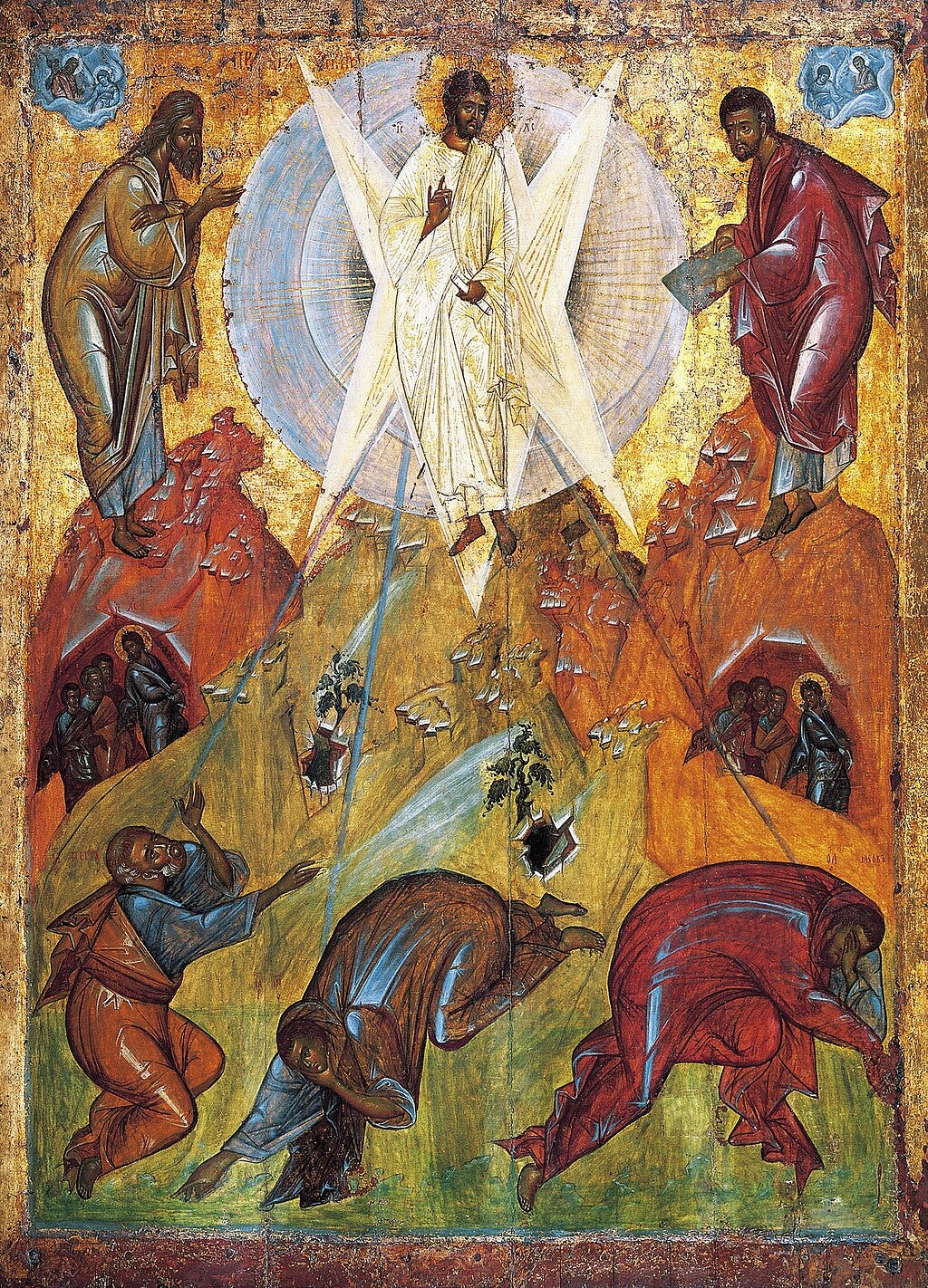Translucent Man: The Fresco of St. Macarios by Theophane the Greek (An Excerpt from "The Uncreated Light")
A free post, with two video clips
Below is a short passage from my book, The Uncreated Light (pp. 105 — 107). Yesterday in the Eastern Church, St. Macarios the Great (c. 300 - 391) was commemorated. One of the most fascinating depictions of him was painted by Theophane the Greek (c 1340 - c. 1410), the teacher of St. Andrei Rublev (c. 1360 - c. 1430). About this icon, I had this to say in my book:
(The Transfiguration of our Saviour in the Elias-street, by Theophane the Greek)
In 1378 Theophane the Greek decorated a church in Novgorod which was called “The Transfiguration of our Saviour in the Elias-street.” The monumental frescoes are still unusually expressive, in spite of the damage incurred by overpainting, restoration and fire. The colour scale is greatly reduced, the facial features and drapery are almost completely erased in many places. These changes, however, do not reduce the content or the power of the work’s expression. The changes entail of course a loss, but can also be interpreted positively, such as we see wear and tear which has value in its own right. Among thse fresco fragments we find a representation of the holy Macarios of Egypt. He is a representation of how man’s “theosis”[deification] involves both body, soul and spirit.
The saint is frontally depicted. He lifts up his hands as in prayer. The body language reflects a listening and open attitude. There are no precise transitions between the hair, the beard and the clothing. These elements are blended together creating an even greyish white background for the terracotta skin colour of the hands, feet and face. Only a weak contour separates the figure from the background colour which is also greyish white, and lights with just a few well-placed brushstrokes. Such as the fresco appears today, there are no nuances between carnation and highlights. The resulting effect can be called expressive minimalism. The simple colour harmonies which do not correspond to the original colours work together to make the intense impression that we stand in front of a mystic who has allowed himself to be totally absorbed by the divine presence. The minimalistic pictorial language emphasizes central contemplative values such as simplicity, humility and spiritual eagerness. Form and content are one.
This painting is not primarily a physical portrait, even though the outer features such as the long hair and beard, the garments made of skin and a body which bears signs of extended asceticism correspond with the historical facts. Macarios appears in an ecstatic, deified state, completely permeated and transformed by the uncreated light. He resembles that which he contemplates. He both sees light and is light.
Macarios radiates the glory Adam had before the fall, a glory which was won back in and through the Incarnation and Transfiguration. The liturgical texts solemnly proclaim what the Transfiguration of Christ means anthropologically when it states that “Transfigured, thou hast made Adam’s nature, which was made dim, to shine once more as lightning, transforming it into the glory and splendour of thy Godhead.” It is further stated that the Transfiguration reveals “the original beauty of the image.” It is this “original beauty” Theophan the Greek shows in his depiction of the transfigured Macarios. According to the mystic’s own words this state can be characterised as:
(The Transfiguration, by Theophane the Greek)
The soul becomes the “throne of God,” it becomes altogether light, altogether a face, altogether an eye; each of its members filled with light, no place is left for darkness, as if it were full of spiritual eyes, on all sides it is a “face” turned toward God, receiving the light of Christ which enters within.
********************************
Regarding Theophane the Greek, here are two YouTube videos that relate to him.
The first is a short clip from Tarkovsky§ brilliant film, Andrei Rublev. It is a fictional depiction of Theophane, but quietly profound. The person who posted it writes:
The scene where Kirill (Ivan Lapikov) first encounters Theophanes the Greek (Nikolai Sergeyev) at his workshop. Kirill is captivated by the painter's latest work, and after assessing it for some time is told by Theophanes, "I see you're clever!", to which he responds, "But what good is there in it? Maybe it's better, in the darkness of your ignorance, to follow your heart's calling?" Theophanes then quotes a passage from the Bible (Ecclesastes 1:18, saying "Too much wisdom brings much sorrow. He that increaseth knowledge increaseth sorrow." This statement is profound on many different levels, and has haunted me ever since I first saw the film.
The second is a musical work, a tone poem, that depicts the great iconographer in another, very beautiful way:
The musical work “THEOPHANES the GREEK” is an original musical composition from Savvas Karatzias written for a mixed choir and chamber orchestra. A musical pilgrimage that follows and reflects in sounds the life of Russian iconography founder Theophanes who was also the teacher of the most important Russian iconographer (Saint) Andrei Rublev.”
The musical work of Savvas Karatzias reflects the journey of Theophanes from the capital of the Byzantine Empire, to the capital of the Russian Empire, a travel that is suggestive of the transfer of the Byzantine culture to Russia which carries on till our days."




